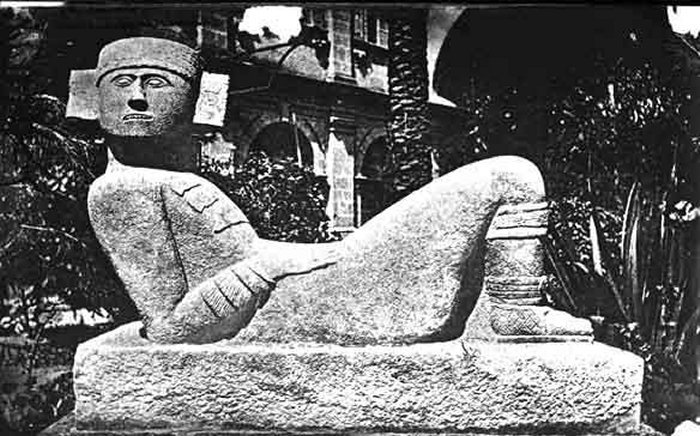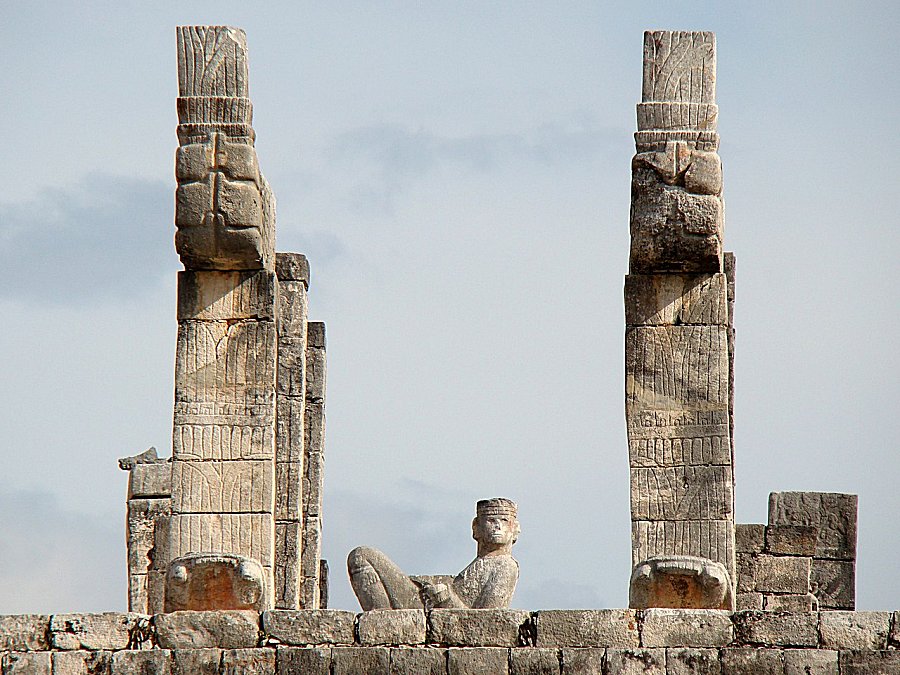Chacmool (‘Chac-Mool’) – Intriguing Pre-Columbian Statue Found At Many Ancient Sites In Mesoamerica
A. Sutherland - AncientPages.com - "Chac Mool" (chacmool, or chaacmol) is one of Mexico's most famous Pre-Columbian statues. Chac-Mool altars are generally found at the entrance to Toltec temples and other pre-Columbian cultural sites where Toltec influence was powerful, for example, Chichen Itza.
Chacmool excavated by Augustus Le Plongeon (d. 1908) from the Platform of the Eagles and Jaguars at Chichen Itza, Yucatan. 1875. Image uploader: Infrogmation - Public Domain
The great city of Chichén Itzá was the most important Mayan political, religious, and military Center in the north of Yucatán during its flourishing years, towards the end of the classic and the beginning of the Postclassic (800-1100 AD).
One such statue, for example, has been discovered in the Temple of Kukulkan (the Plumed Serpent), one of the most famous Maya pyramids - built at Chichén Itzá and later renamed El Castillo by the Spanish.
Archaeology confirms that twelve chacmools have been discovered at the Toltec city of Tula, known for its famous Atlantean Statues, the massive stone sculptures of warriors, the "Atlantes" that still hold a mystery: how the figures were carved and transported to the pyramid's top.
Usually, the sculpture is approximately human-sized and decorated with a headdress, bracelets, ear flares, and anklets. It depicts a resting man with his head directed to the left or the right but always facing 90 degrees from the front. The statue's posture is unique.
Curiously, this individual is always looking out away from the associated temple, supporting itself on its elbows and, at the same time, keeping a bowl (or disk) placed upon its torso. The bowl probably served as a holder for sacrificial blood and burnt offerings. It may also have had a symbolic meaning associated with the circular cenotes, which are deep sinkholes or holes particularly characteristic of Central America and Mexico and used during religious ceremonies (sacrifices) during the Mayan Empire.
What Is The Original Name Of The Statue?
As far as we know, Augustus Le Plongeon named "chac mool" after a mysterious statue he discovered during an archaeological expedition to Chichen Itza in 1873. However, the first published account of this kind of statue first appeared in 1832.
 Maya Chacmool from Chichen Itza displayed at the National Museum of Anthropology. Image credit: Ziko van Dijk - CC BY-SA 3.0
Maya Chacmool from Chichen Itza displayed at the National Museum of Anthropology. Image credit: Ziko van Dijk - CC BY-SA 3.0
Le Plongeon, a British-American archeologist and photographer, studied the pre-Columbian ruins of America and focused his research on the Maya civilization living on the northern Yucatán Peninsula. He discovered several important sites of Mayan culture and wrote several books later criticized by the scientific community as based on the author's flawed ideas.
According to Le Plongeon, the statue was supposed to represent an ancient Mayan king named "Chac-Mool" ("red Jaguar"), but the researcher was wrong, and historians have rejected his theory. According to the Maya, "chac-mool" means "the paw swift like thunder" (or "Thunderous Paw"), but the simple name "chac mool" has been widely adopted by researchers.
It's important that the statue's name, "Chac Mool," should not be confused with Chac, one of the foremost gods of Mayan mythology, who was initially related to rain, storms, and thunder. Aztec chacmools were associated with Tlaloc, the Mesoamerican rain god and the important deity in the Aztec pantheon.
Unknown Real Name, Identity And Function Of This Pre-Columbian Statue
The ancient name for these types of sculptures is unknown. It is also still being determined what or who the statue represents or its purpose.
Chuck-Mool. Statue at the top of the Temple of Warriors of the Chichen Itza complex. Credit: Bjørn Christian Tørrissen, One for the Road. CC BY-SA 3.0
What was the statue's original function? The Chaacmol does not appear to be of Maya origin. What mysterious ancient culture does he represent? Who were the male figures representing chacmools?
For over two centuries, "chacmool" has remained the subject of scientific speculations, and some possible explanations for this curious pre-Columbian figure are widely accepted.
As chackmools have never been discovered inside the temple's sanctuary or shrine, they have not been a subject of worship. Instead, they have been used by priests during their religious ceremonies. The statue could be a cuauhxicalli ("eagle gourd bowl") to receive blood and human hearts during sacrificial rituals prevalent among the Aztecs. The Aztecs used this bowl instead of the usual disc-altar. A chacmool from Tlaxcala. Mexico, for example, has a bloodied heart sculpted on the underside, supporting this interpretation.
It was also proposed that the bowl (or similar vessel) was used for collecting donations and gifts such as tobacco, turkeys, feathers, incense, tortillas, and pulque.
Or was Chac Mool perhaps a sacrificial stone over which victims were stretched so their hearts could be cut from their chests? In other words, "chacmools" were most probably related to the bloody ceremonies of the ancient Maya people.
Enigmatic monumental sculptures of "chacmool" were still in use when the Spanish contact in Central Mexico in the Aztec capital, Tenochtitlan, in the region of Chichen Itza) far as in El Salvador. In other Maya areas, researchers found fewer of these statues.
Updated on Nov 26, 2023
Written by – A. Sutherland - AncientPages.com Senior Staff Writer
Copyright © AncientPages.com All rights reserved. This material may not be published, broadcast, rewritten or redistributed in whole or part without the express written permission of AncientPages.com
Expand for referencesReferences:
Salisbury S. and Le Plongeon, A. The Mayas, the Sources of Their History Dr. Le Plongeon in Yucatan, His Account of Discoveries
More From Ancient Pages
-
 Countess Loretta Of Sponheim Kidnapped Archbishop Of Trier And Got Away With It
Featured Stories | Sep 26, 2018
Countess Loretta Of Sponheim Kidnapped Archbishop Of Trier And Got Away With It
Featured Stories | Sep 26, 2018 -
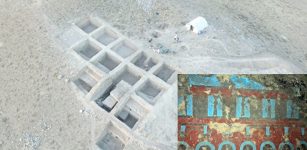 First Look At Mysterious 2,700-Year-Old Underground Frescoes Hidden Inside An Urartu Structure
Archaeology | Oct 6, 2022
First Look At Mysterious 2,700-Year-Old Underground Frescoes Hidden Inside An Urartu Structure
Archaeology | Oct 6, 2022 -
 What Was The Danelaw?
Ancient History Facts | Jun 4, 2016
What Was The Danelaw?
Ancient History Facts | Jun 4, 2016 -
 Ancient People In Peru Had A Unique Response To The Looting And Destruction Of Their Ancestors’ Graves
Archaeology | Feb 3, 2022
Ancient People In Peru Had A Unique Response To The Looting And Destruction Of Their Ancestors’ Graves
Archaeology | Feb 3, 2022 -
 Massive Menhir Champ Dolent Built By Fairies In Ancient Beliefs Of Brittany’s People
Featured Stories | Jan 13, 2025
Massive Menhir Champ Dolent Built By Fairies In Ancient Beliefs Of Brittany’s People
Featured Stories | Jan 13, 2025 -
 Thor: Brave And Mighty Thunder God In Norse Mythology
Featured Stories | Nov 7, 2016
Thor: Brave And Mighty Thunder God In Norse Mythology
Featured Stories | Nov 7, 2016 -
 Huangluo: Long-Hair Village Where Women Don’t Cut Their Hair – A 2,000-Year-Old Tradition Of The Yao People
Ancient Traditions And Customs | Jun 18, 2017
Huangluo: Long-Hair Village Where Women Don’t Cut Their Hair – A 2,000-Year-Old Tradition Of The Yao People
Ancient Traditions And Customs | Jun 18, 2017 -
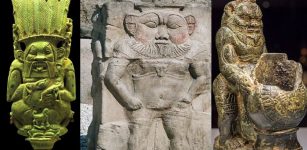 Bes – Ancient Egyptian Dwarf God Of Childbirth, Humor, Song and Dance
Egyptian Mythology | Sep 9, 2016
Bes – Ancient Egyptian Dwarf God Of Childbirth, Humor, Song and Dance
Egyptian Mythology | Sep 9, 2016 -
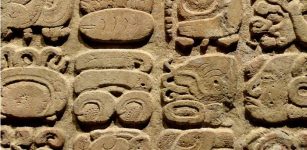 On This Day In History: Spanish Priest Diego de Landa Burned The Sacred Books Of Maya – On July 12, 1562
News | Jul 12, 2016
On This Day In History: Spanish Priest Diego de Landa Burned The Sacred Books Of Maya – On July 12, 1562
News | Jul 12, 2016 -
 Mama Quilla – Incan Moon Goddess Of Marriage And Fertility Assisted By High Priestesses Of Qoricancha
Featured Stories | Jun 15, 2020
Mama Quilla – Incan Moon Goddess Of Marriage And Fertility Assisted By High Priestesses Of Qoricancha
Featured Stories | Jun 15, 2020 -
 On This Day In History: Declaration Of Independence Of The Mexican Empire Is Drafted – On Sep 28, 1821
News | Sep 28, 2016
On This Day In History: Declaration Of Independence Of The Mexican Empire Is Drafted – On Sep 28, 1821
News | Sep 28, 2016 -
 525-Million-Year-Old Fossil Defies Textbook Explanation For Brain Evolution
Archaeology | Nov 25, 2022
525-Million-Year-Old Fossil Defies Textbook Explanation For Brain Evolution
Archaeology | Nov 25, 2022 -
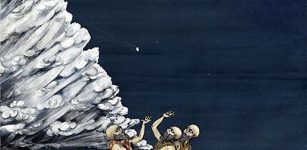 Controversial 5,500-Year-Old Sumerian Star Map Of Ancient Nineveh Reveals Observation Of Köfels’ Impact Event
Artifacts | Dec 28, 2018
Controversial 5,500-Year-Old Sumerian Star Map Of Ancient Nineveh Reveals Observation Of Köfels’ Impact Event
Artifacts | Dec 28, 2018 -
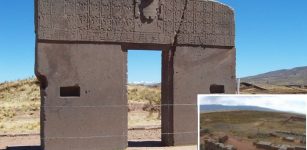 Underground City And Pyramid Discovered At Tiahuanaco, Bolivia
Archaeology | Aug 3, 2018
Underground City And Pyramid Discovered At Tiahuanaco, Bolivia
Archaeology | Aug 3, 2018 -
 Sinister Manchac Swamp And The Chilling Curse Of Julia Brown
Featured Stories | Aug 25, 2021
Sinister Manchac Swamp And The Chilling Curse Of Julia Brown
Featured Stories | Aug 25, 2021 -
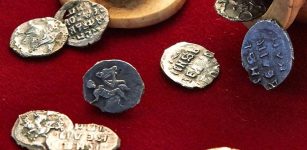 Silver Coins Hidden In Chess Figure Date Back To Ivan The Terrible’s Days – Discovery In Moscow
Archaeology | May 13, 2017
Silver Coins Hidden In Chess Figure Date Back To Ivan The Terrible’s Days – Discovery In Moscow
Archaeology | May 13, 2017 -
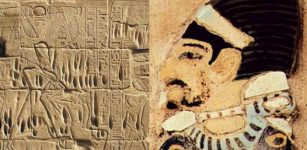 Mysterious Shasu – Bandit Canaanites Or Israelites?
Civilizations | Jan 14, 2019
Mysterious Shasu – Bandit Canaanites Or Israelites?
Civilizations | Jan 14, 2019 -
 Ancient Marble Statue Of Sphinx Discovered In Tang Dynasty Tomb
Archaeology | Dec 16, 2015
Ancient Marble Statue Of Sphinx Discovered In Tang Dynasty Tomb
Archaeology | Dec 16, 2015 -
 Ancient DNA From Medieval Germany Reveals The True Story Of Ashkenazi Jews
Archaeology | Nov 28, 2022
Ancient DNA From Medieval Germany Reveals The True Story Of Ashkenazi Jews
Archaeology | Nov 28, 2022 -
 7,000-Year-Old ‘Immortal City’ Of Misis – Excavations Shed Light On Its Fall
Archaeology | Aug 25, 2015
7,000-Year-Old ‘Immortal City’ Of Misis – Excavations Shed Light On Its Fall
Archaeology | Aug 25, 2015

